The current state of solar energy in the US household
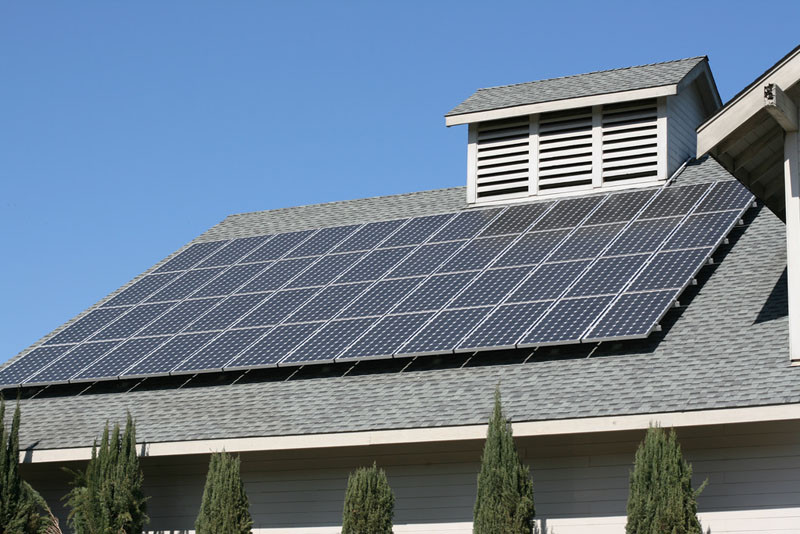
Just do not panic, but by 2050 we will need to generate 15 TW of energy from renewable (non-increasing carbon dioxide) sources to stabilize the concentration of CO 2 in the atmosphere. And in terms of availability, solar energy has the greatest potential for this today.
Solar energy is "probably the only solution to get energy, both serious enough in terms of impact and acceptable enough for the long-term [environmental] requirements of the planet," says Richard Perez, chief researcher at the Atmospheric Sciences Research Center at New York State University. in Albany. Perez's analysis includes geothermal sources, wind, other renewable sources, nuclear fusion, and all types of fossil fuels.
')
So, if wind, hydropower and geothermal sources in some regions operate on a local scale, today's potential of solar energy exceeds any other source of renewable energy by several orders of magnitude . It is the only candidate, apart from nuclear energy, for a global solution to extract huge amounts of energy.
On average, about 175 W / m 2 of solar energy gets to Earth. If we assume that 10% of this energy can be converted into electricity, then the supply of necessary US energy will require covering 2% of the US land with solar panels - this is approximately the area of North Dakota. Since this is 30 times the area of our roofs , it will be necessary to build large solar power stations to collect this amount of energy.
But this does not diminish the utility of several panels on your roof. If you have your own home, you can, in principle, generate electricity yourself. You can reduce or eliminate your dependence on the electricity supplier - and maybe even sell it to the surplus, further reducing the cost or even making a profit.
The recent change of state leader hints at the uncertainty of the situation with US solar initiatives. But individual organizations, enterprises and citizens can decide for themselves whether to increase their use of solar energy. To better understand the current state of home use of solar energy in the US, we familiarized ourselves with the practice, the economic side of the issue and the experience of various people who have recently turned their homes into small power plants. We hope that even if you live in an apartment in the basement, this information will be able to ... enlighten you.
Better than ever
In childhood, we admired the calculators and watches, working from the sun. Some received as a gift scientific kits, where tiny motors were combined with palm-sized solar panels. Creating electricity from light seemed like magic. Why can't we do it all over the world?
One of the main historical obstacles to civilization living on solar energy is the low efficiency and high cost of solar panels (SPs) - plates that convert photons into electricity. Their efficiency, more precisely, the photovoltaic conversion factor , is the ratio of the electrical energy produced by the panel to the energy of sunlight falling on its surface.

One of the first joint ventures
Their story is quite long. The first joint venture was invented in 1883 by Charles Fritts, who dreamed of how his joint venture would compete with the growing network of Thomas Edison coal-burning power plants. But the 1% efficiency of its joint venture made the fulfillment of a dream impossible.
By 1954, Bell’s laboratories showed the public a joint venture by connecting it to a toy ferris wheel and to a radio transmitter. The device had an efficiency of 6%, which was a significant achievement compared to the previous joint ventures. It was also actually a panel in which several photocells were connected to a solar panel. Although it was still too expensive for widespread distribution, The New York Times was impressed by the demonstration and declared it "the beginning of a new era, which will lead to the realization of one of the most precious hopes of mankind - the development of almost unlimited solar energy for the needs of civilization."
In the 50s and 60s, studies of silicon SP continued. Small joint ventures began to appear in toys and consumer devices. By the middle of the decade, efficiency had doubled , but the cost remained too high, especially when compared to the low cost of electricity at that time. The one-watt JV cost $ 300, and the cost of 1 W of energy received from power plants was 50 cents.
But by the end of the decade, the joint ventures showed their usefulness as an energy source for a whole fleet of artificial satellites. The US Navy, initially skeptical of the joint venture, changed their minds when a conventional battery on the first satellite died a few days later. A joint venture supported his performance over the years.
The cost of high-quality joint ventures used in satellites and in space equipment, although high, amounts to only a fraction of the total cost of these systems, and the relatively low cost of fuel and ground energy in the 50s and 60s did not stimulate their cost reduction. But by the early 1970s , joint ventures using cheaper materials had been developed , and the cost of the panels had dropped to $ 20 per watt. Together with the energy crisis of 1973, this sparked a new wave of interest in solar energy in terms of its terrestrial use.
But the technology was still not ready for the mass market: efficiency was around 10%, and the cost remained high.
Today, there is an increasing interest in solar energy, both at the household level and on a larger scale. All this is due to the addition of several factors: a decrease in cost; increase of efficiency of the joint venture; stimulating environment from regulators and taxes; widespread climate change concerns; entrepreneurial innovation.
A surge of interest is associated with an exponential growth in the use of solar energy over the past 20 years. Perspectives for growth remain. In no less than 30 countries , including some in the United States, energy from a joint venture on the roof becomes cheaper than from a network - and this does not include subsidies for their purchase.
What else helped the joint venture to come to life was a market with many alternatives to conventional panels located on the roofs. Some companies sell aesthetically more attractive options , such as, for example, a joint venture in the form of roofing (the result is a shiny roof, rather than panels protruding from it). One firm offers small homes designed for different customers, including the segment of those consumers who are trying to minimize their contribution to greenhouse gas emissions. Some of these products come with integrated solar roofs and the ability to work completely autonomously.
Ilon Musk said recently that his “solar roof” in the installation would be cheaper than usual, even without considering its ability to generate electricity. Such an option would make the choice of a solar roof risk-free during construction.
Also, homeowners are not limited to rooftops. The same technology is applicable to carports for cars and other individual structures, and joint ventures can be installed even in the field or in the yard.

Autonomous station that monitors the state of the water
And although we are concentrating on solar energy in households, it is worth noting the growing segment of medium-sized joint ventures. They are more than home-made, but less than large-scale solar power plants. In a recent trip to Maryland and Virginia, we noticed several plots of land planted with rows of joint ventures, and not corn or pastures for cows. Small solar power plants are becoming a popular way of getting solar power to small communities without the need for every community member to buy their own system.
The kind of joint ventures interspersed with grains reminded us that this is simply the newest way to exploit the abundant and free energy of the Sun - converting it into electricity, and not into sugar through photosynthesis.
Dollars and kilowatt hours
So you decided to start collecting solar energy. Is it a reasonable investment?
For many people, this is not just a calculation of income and expenses: the realization that you reduce your contribution to greenhouse gas emissions may outweigh purely financial considerations. And those who invest in an autonomous system with batteries get satisfaction from safety and independence from the local infrastructure.
But the system costs money. If you have not made a good deal with the installer, for most people, installing a joint venture on the roof is a serious investment. These costs are reduced by reducing your electricity bill, and possibly selling your energy to the grid.
In addition to such general statements, it is impossible to make certain predictions about the cost of home solar energy. This is because all factors related to this are very much dependent on where you live. In cities where electricity costs are highest, an investment in solar panels on the roof can compete with an investment in an index fund. Where the cost of electricity is lower and the weather conditions make the joint venture ineffective, this can be a waste of money (not counting the above other reasons). The cost of selling electricity back to the grid also depends on the regions.
Energy researcher Joshua Rhodes notes that the average cost of solar energy from a joint venture on the roof, given installation, lifetime and other factors, in the US is now equal to the cost of energy from the network: about 12 cents per kWh. This could be a turning point, meaning that every homeowner, real or potential, should seriously consider the joint venture as part of its investment.
But these numbers hide the details. The cost of energy derived from the network in the country can vary by 10 times, and the cost of installing the panels, as well as sunlight, also vary greatly. Rhodes collected his data on maps showing where the home solar energy is worth the investment, and where it is not yet ready for implementation.
As a result, there are large regions where both the cost of energy and the amount of sunlight, such as southern California, are high - installing panels there might be a good idea. Washington State is bad with the sun and cheap electricity, so there might be no point in this.
But this information quickly becomes outdated. Ordinary, silicon joint ventures, constantly fell in price, mainly due to economies of scale. This process may be approaching market saturation , and future cost reductions may be based on studies of new types of photovoltaic cells or production methods.
Real example
Nick White lives in Denver, Colorado, he installed a joint venture on the roof a little over a year ago and kept detailed records. He shared them with us, and their study will be informative.

Nick tracked the output of his solar system and found that the joint ventures generated approximately 3,400 kWh of electricity in the first year of operation. During this period, his household consumed about 4,200 kWh, which is 800 kWh more than the Sun gave. Surplus came from the mains.
Electricity from the network costs 13 cents per kWh, so a bill for 800 kWh would be $ 104. But according to the rules, an energy company must pay White 3 cents for each kWh produced by its panels. This subsidy is designed to reduce the cost of installing a joint venture. In other states there are similar subsidies.
The total panel fee was 3400 * 3 c, i.e. $ 102. As a result, White’s account was $ 2. Without panels, the score would be 4,200 kWh * 13 c, or $ 546, so the Sun brought a profit of $ 546 - $ 2 = $ 544 per year.
White points out that a $ 544 refund divided by the installation cost of $ 7,672 (after tax refunds) gives him a% 7.09 refund (not counting interest on the installment credit). White believes that he has invested correctly. And since over the years the cost of electricity from the network increases, the savings will also increase, even with a slight degradation of the efficiency of the panels.
Regarding their work, he says: “I don’t think about them at all. They are always on, and there is no need to look after them. ”
The energy consumption of White’s home is so modest (about half of the average in his region) because he invested in efficient technologies before installing the JV. He estimates that the savings from the use of LED lamps and efficient home appliances is obtained even more than from panels.
Perhaps more important than the financial aspect of the panels will be the fact that the White family has slightly reduced greenhouse gas emissions: 60% of Colorado’s energy comes from burning coal . For him, this is the "best of all results."
The whites travel a lot in a motorhome, which they also supplied the joint venture on the roof. This is an autonomous system with batteries. They estimate that an autonomous motorhome costs 2-5 times more than a regular one.
Perhaps a useful example from abroad
Before you think about installing a joint venture on the roof, you need to estimate the available surface area and the amount of sunlight it receives. This will allow you to determine if the system can produce enough energy to make it make sense. Local installers can make calculations for you, but it’s certainly profitable for them to sell panels to you. So, in general, it would be a good idea to figure out on your own what can be expected from the system before going to such a company.
Project Sunroof is a website from Google that, upon receiving your address, will combine the data about your roof with local weather and shade and will try to calculate the economic aspect of the joint venture on the roof of your house. It can be useful as a rough estimate, or help in choosing between several options for the houses you want to buy, but the project is still at an early stage, and is not capable of detailed analysis. For example, he believes that the entire surface of the roof is available for the installation of a joint venture, although it is possible that local laws and practical considerations will not allow to occupy it all. And at the time of this writing, the site does not work at all possible addresses.
An example of the non-standard use of solar energy, which Google algorithms are unlikely to be able to calculate, will be the experience of Chris de Decker, who runs his blog “The Journal of Low Technologies” from his apartments near Barcelona in Spain. He recently decided to conduct an experiment and power his office exclusively from solar panels. And although we are talking about the United States here, his experience is interesting. The average solar energy in Barcelona at 1,700 kWh / m 2 / year coincides with the United States.
De Decker does not have access to the roof, so he took advantage of the windows. It turned out that they ideally overlook the direction between the south and southeast, and they are not obscured by trees or buildings. But the small panels that were placed on his windowsills were not enough to power the office.
He was able to increase the output of the joint venture by building holders for them so that the panels were tilted at an angle that collects the most energy from the sun (photo below). Such a strategy is followed in solar power plants, but it is usually not available for typical houses where the panels are simply mounted on the roof. De Decker increased the average annual output by about 10%, periodically changing the angle of the panels, while this advantage actually turned out to be more than it seems. The increase in output was due to the winter period, when it is just very important to squeeze all the available watts from the system. In these months, the inclined panel can produce 3 times more energy than the horizontal one.
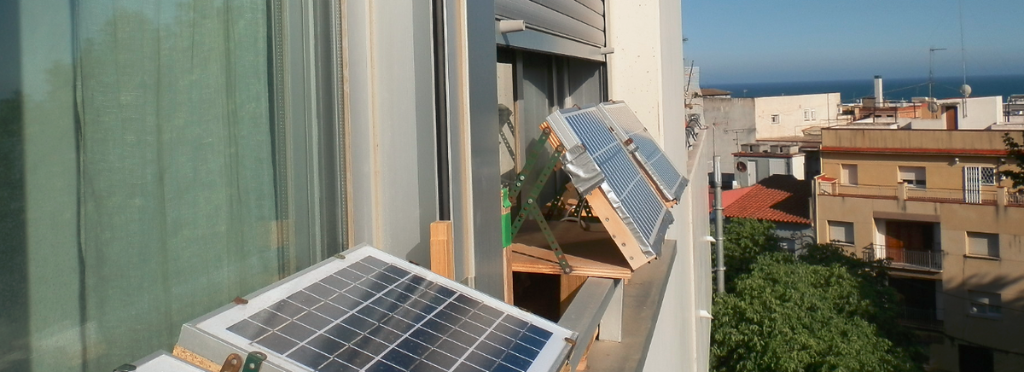
More important was the transformation of his office into a 12-volt DC system. Different SPs produce a DC current of different voltages, and 12 V is the most common voltage for small panels. This is convenient for powering many electronic devices, for example, laptops running from 12 V. When you turn on the laptop in an AC network, the power supply turns 120 V (in the US) AC into 12 V DC, resulting in energy loss. This loss is easy to feel on the heating unit.
In order for a typical solar collection system to be combined with electrical wiring, its direct current is fed through an inverter and a transformer that converts it to 120 V and 60 Hz (in the USA) required for home electronics. Instead of converting the output of the panels and losing energy, de Decker converted the devices so that they consume 12 V current directly from the panels. In most cases, it was enough for this to use a different power cord. As a result, 40% of the energy was saved, which greatly influenced the success of his experiment.
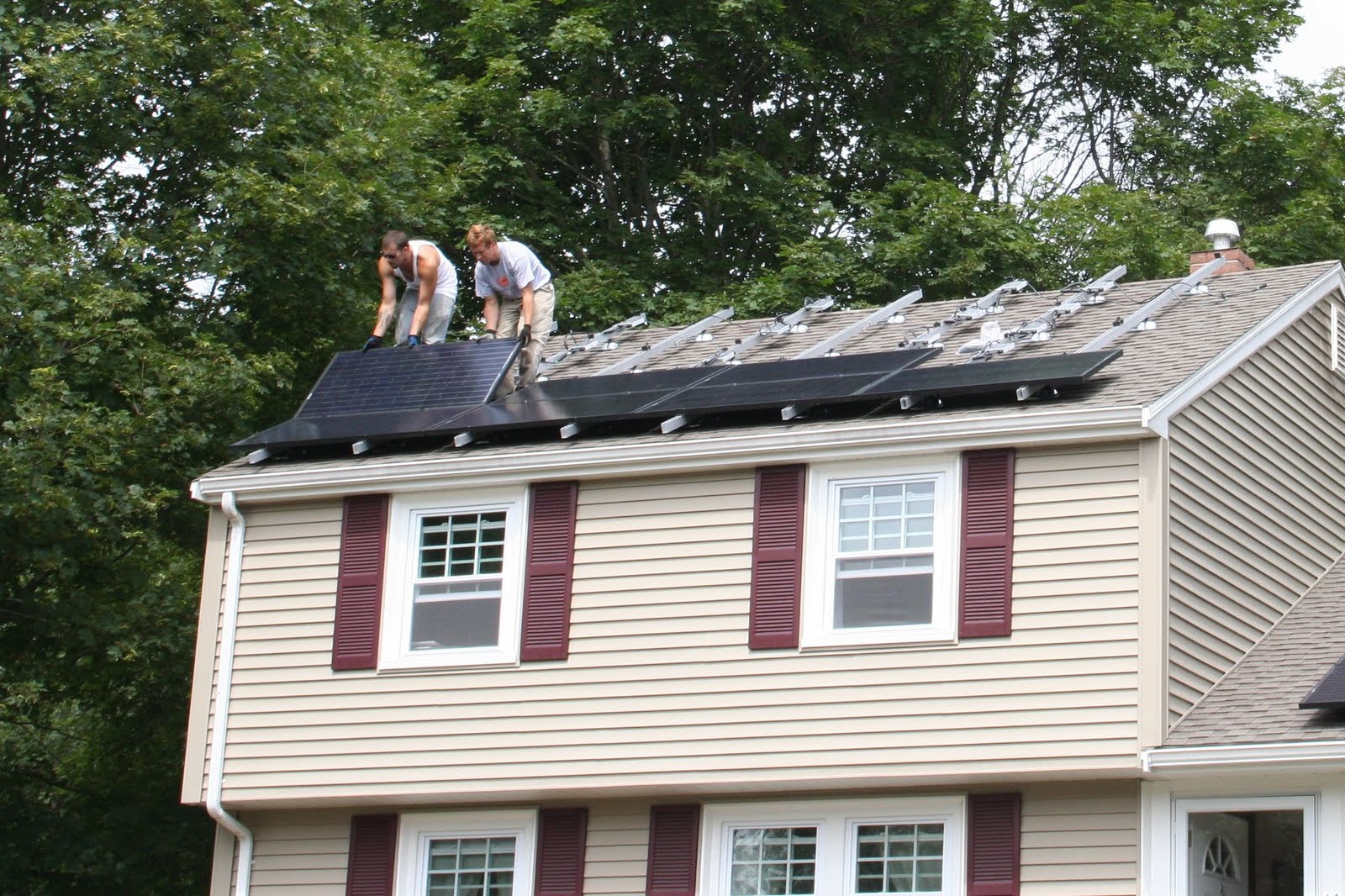
JV Installation in Massachusetts
Our last example came from Benjamin Meyer, who lives in Massachusetts. The climate in New England is not ideal, and the panels are often covered with snow. However, during the year they generated more energy than the household consumed. Meiers responded by installing air conditioning and other appliances to bring consumption into line with production. 5 years after the installation, the panel paid for itself, if we consider the subsidies from the state and tax concessions.
“I rarely think of panels,” said Meyer. - The most difficult thing was to install them and turn them on for the first time, and watch the meter spin in the opposite direction, knowing that you are not paying anything for electricity. I think everyone who set himself a panel can tell you about this moment. ”
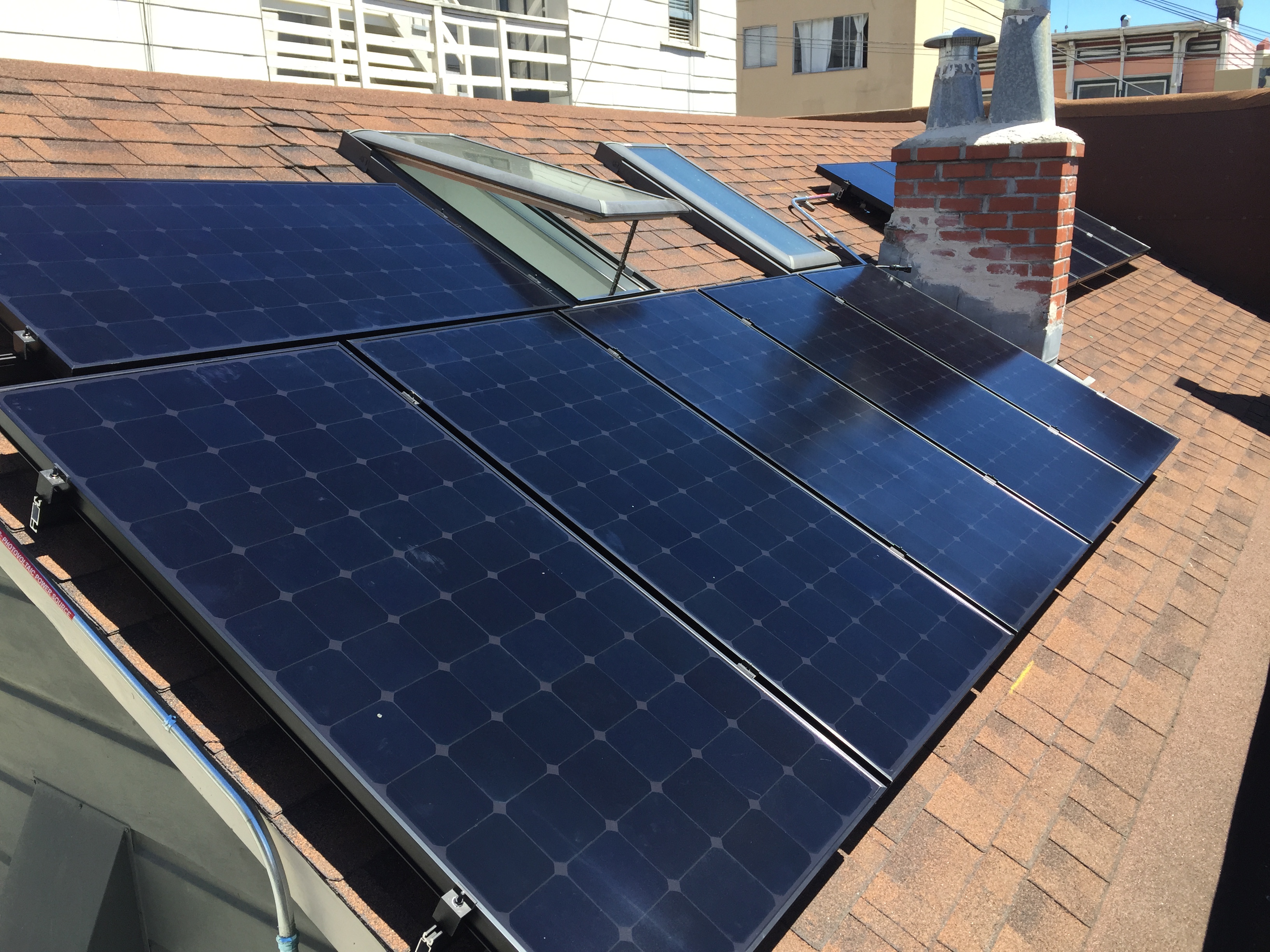
Rooftop joint venture in california
At the other end of the country, in San Francisco, Dan Birken, a programmer, kindly agreed to consult us. His joint venture on the roof gives energy for almost a year. He describes his JV costs as “not the best investment,” but notes that “I didn’t buy them for investment reasons, but because I wanted to have my own panels, since this is not the worst investment. It's fun to get your own energy from the sun. ”
Birken estimates that his system saves him from $ 900 to $ 1,200 per year, including the cost of selling energy back to the network.
Birken's house fell under the common law prohibiting to place a joint venture closer than 90 cm from the ridge of the roof. This is done so that firefighters could move around on the roof in case anything happens, but the law reduces the usable area of the already small roof. Popular online calculators do not usually take into account such subtleties.
Offer you cannot refuse
There is no doubt that kWh from large-scale solar power plants are cheaper than from small households. In general, the cost of energy of large solar power stations has recently become slightly lower than that of gas-fired thermal power plants.
One of the reasons for the attractiveness of home joint ventures is the opportunity to get good subsidies that reduce the cost of the system. In the US, there are now several rules that make domestic joint ventures attractive. Now there is a 30% tax rebate on the installation of solar energy systems; it will work until 2019, then it will decrease, and in 2021 it will disappear. With some reservations, it is also applicable to solar water heating systems .
This discount has already greatly stimulated research in the field of joint ventures and their home installation. Although it will soon disappear, previous tax concessions have been extended . Congress will consider tax rebates on an annual basis, so this may change. In addition to federal discounts, there are also discounts for specific states.
Another type of stimulation of solar energy use recently entered into force in San Francisco. As an excellent example of a proposal that cannot be refused, the city obliges to equip all new buildings with some type of system for obtaining energy from the sun.
Fight against darkness
Let's make an obvious statement: solar panels do not work at night or under snow. However, usually we need electricity around the clock.To do this, we need to store the excess energy obtained by sunny days and extract it when generation is not available.
Large solar power plants , state and commercial, use different ways of storing energy, and can choose the best option, depending on the environment. They can store solar energy in the form of a gravitational potential, pumping water into elevated reservoirs, and then receiving energy by draining water through turbines. They can compress containers with gas or springs, use chemical energy in conventional batteries, or use more complex processes, such as the production of hydrogen from water, which can then be burned.
The only practical solution for a home system from this list would be an electric battery. But at the current stage of technology development, the cost of buying and maintaining a battery system is very high. As a result, most people use an electrical connection and refuse autonomy. This allows you to sell excess energy to the grid during the day and take electricity from the network at night or at any other time when the panels are not working.
Using the power grid as a battery makes installing a joint venture not only easier and cheaper, but also allows the system to pay for itself more quickly, since in many states the power companies have to pay households for the energy transferred to the network. However, during a local blackout, when energy may be most needed for you, your system will shut down for security reasons for the utility company who will repair the network.
Batteries are the obvious choice for organizing energy storage, and usually these are lead-acid batteries, such as in cars. Recently, Tesla Motors announced that it has adapted the technology of lithium-ion batteries used in its electric vehicles for use at home as a backup battery. PowerWall devicedesigned to work both to collect solar energy and to provide backup power in the event of a power outage.
Improving the efficiency of batteries and reducing their cost is just as important as improving the efficiency of solar panels. If recent progress continues , such systems will become more popular. If the market share of electric cars will increase, such batteries can become the primary method of energy storage and a demand leveling system - after all, everyone who buys an electric car will already invest their money in the battery.
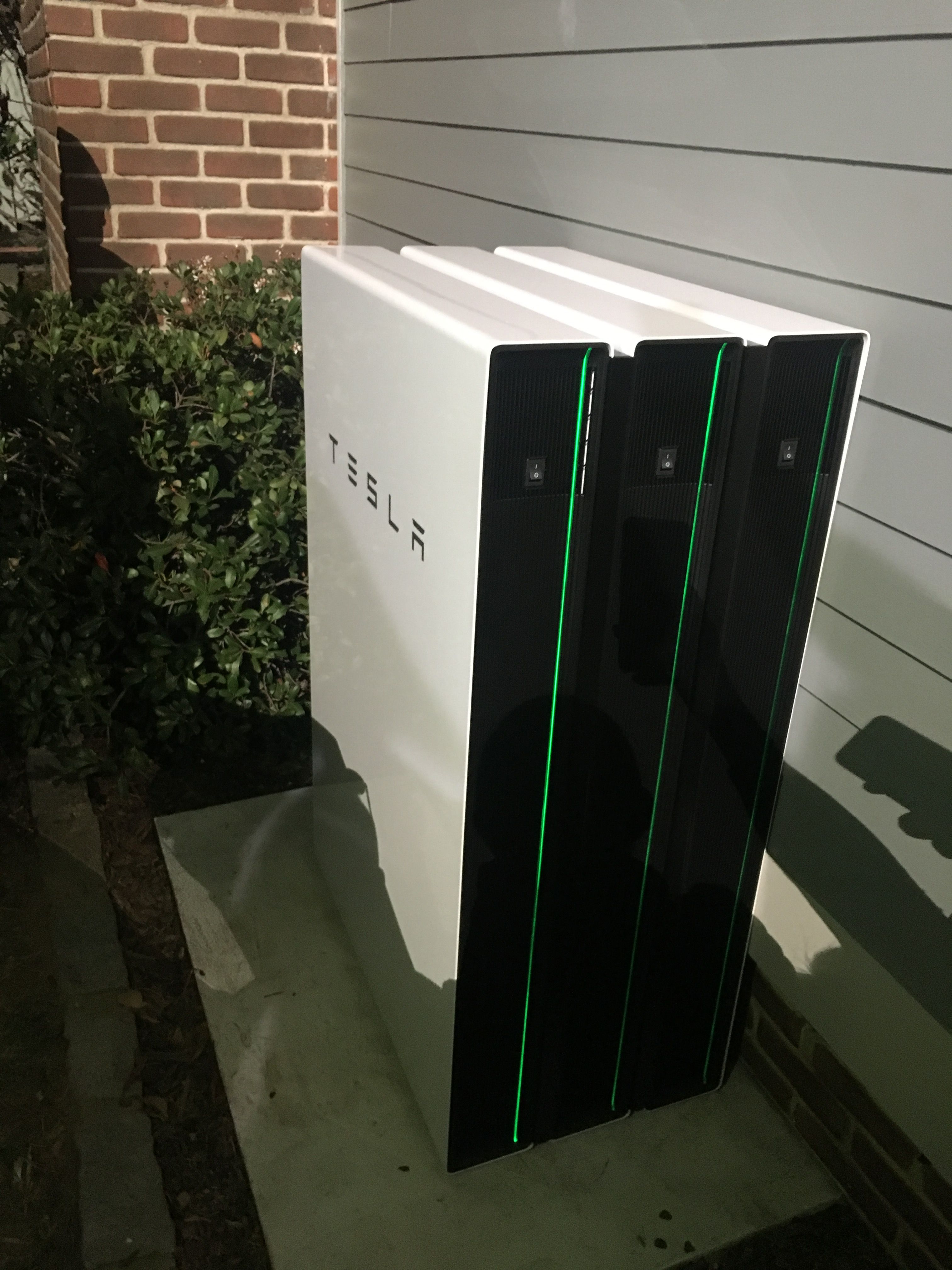
PowerWall 2 SolarCity's
recent purchase by Tesla of a company is part of a strategy (in financial circles viewed with a great deal of skepticism) the creation of a vertically integrated company that supplies solar energy, systems for its storage and vehicles that consume it - despite the fact that these cars will potentially become part of the energy storage system. Analysts predict that by 2020, Tesla car batteries will store 70 GW of energy - not counting the machines of other manufacturers.
Tesla has so seriously invested in the Tesla project that in 2016 installed more batteries than all companies installed in 2015 in the United States. The company intends to produce "an easily integrable and beautiful system" solar roof with a battery "that just works, gives energy to the consumer, and then scales it around the world." After purchasing SolarCity, Musk and the company announced plans and technical achievements that coincide with this goal, includingadvanced inverters and solar roofs .
Those who have read up to this point it is clear that the history of home solar energy is complex and subject to constant changes, thanks to the rapid progress in research and the constantly changing tax landscape. But technology and economics have already reached such a state that we can be sure that joint ventures on the roof definitely make sense if you have your own house in the sunny region ... unless, of course, local rules and laws raise too many obstacles.
For homes in less favorable climatic conditions, it is more difficult to prove the rationality of the installation of the joint venture But you can still be convinced by some independence from the local energy company, as well as joining the ranks of citizens who responsibly approach the climate problems of our planet.
Source: https://habr.com/ru/post/401665/
All Articles